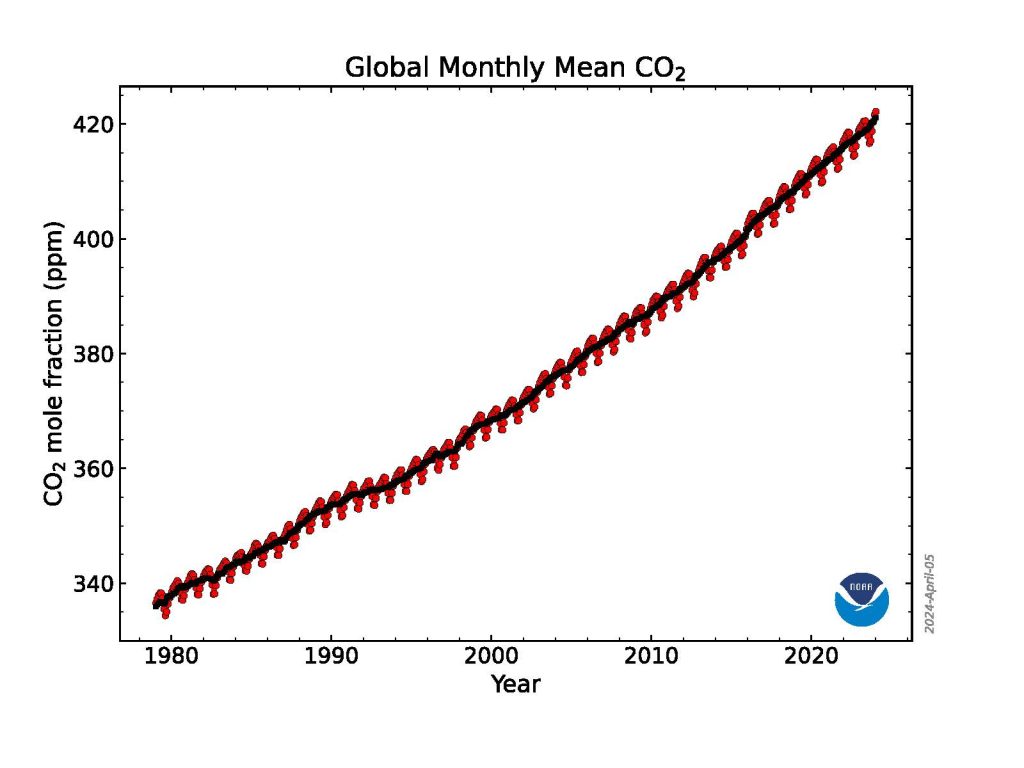Atmospheric concentrations of three main greenhouse gases – carbon dioxide, methane, and nitrous oxide – climbed to unprecedented levels in 2023, spurring a rise in global temperatures and widespread extreme weather events.
—
Record highs levels of atmospheric concentrations of the three most potent greenhouse gases in 2023 show that the world still has “a lot of work to do” to avert the catastrophic consequences of climate change, scientists said on Friday.
According to US National Oceanic and Atmospheric Administration’s (NOAA) latest data, levels of all three main planet-warming, human-caused greenhouse gases – carbon dioxide (CO2), methane, and nitrous oxide – reached record highs in 2023, albeit growing at a slower pace than previous years.
Global concentrations of CO2, Earth’s most important heat-trapping gas generated from the extraction and burning of fossil fuels and by far the most important contributor to climate change, reached a significant milestone, averaging at 419.3 parts per million (ppm) throughout 2023. This represented a 2.8 ppm increase from the year prior – the third-largest in the past decade. Notably, atmospheric CO2 now exceeds pre-industrial levels by over 50%.

A paper published in December 2023 had already confirmed last year’s record levels of fossil CO2, with lead author Professor Pierre Friedlingstein of Exeter’s Global Systems Institute arguing that progress remains “painfully slow” and is currently not widespread enough to put the world on the right path to reach net zero emissions.
Recent findings suggested that, at current CO2 emissions levels, the remaining carbon budget for a 50% chance to limit global warming to 1.5C could be exceeded in seven years. Carbon budget refers to the net amount of CO2 we have left to emit before we exceed our desired global temperature increases.
More on the topic: Drought-Driven Shortfall in Hydropower Generation Partly to Blame for Record-High Global CO2 Emissions in 2023, IEA Says
According to NOAA, methane levels also rose to an average of 1,922.6 parts per billion (ppb) in 2023, a 10.9 ppb increase from 2022 – the 5th highest since renewed methane growth began in 2007. Atmospheric methane levels are now 162% higher than pre-industrial levels, alarming the scientific community.
Methane, a major contributor to the total greenhouse gas (GHG) emissions, second only to carbon dioxide (CO2), is responsible for about 30% of global warming. Anthropogenic methane accounts for 60% of the total methane emission, with 90% coming from three main sources: agriculture (40%), fossil fuel (35%), and waste (20%).
Last month, a new satellite that will track and measure methane emissions at a global scale, was launched. MethaneSAT – the result of a partnership between Google and the Environmental Defense Fund (EDF) – will orbit the Earth 15 times per day, surveying methane levels over the world’s largest oil and gas regions. The information collected will be processed through algorithms powered by Google Cloud and by the end of the year, the company expects to have data mapped for the whole world to see.
Nitrous oxide levels, the third-largest human-caused greenhouse gas, reached 336.7 ppb in 2023, a 1 ppb jump from the year prior. The surge in atmospheric nitrous oxide is primarily attributed to the expansion and intensification of agriculture, specifically due to the use of nitrogen fertilizer and manure. As a result, nitrous oxide concentrations now stand at 25% higher than the pre-industrial level of 270 ppb.
“As these numbers show, we still have a lot of work to do to make meaningful progress in reducing the amount of greenhouse gases accumulating in the atmosphere,” said Vanda Grubišić, director of NOAA’s global monitoring laboratory. Greenhouse gases are contributing to a significant increase in global temperatures and associated impacts from extreme weather events, which are becoming more frequent and intense worldwide.
You might also like: Extreme Weather Events Cause $200bn in Economic Losses Globally, Philippines and US Hit the Hardest, Report Finds
2023 was the hottest year on record, supercharged by the return of El Niño, a weather phenomenon that has pushed temperatures off the charts around the world and that is expected to last well into 2024. As expected, the trend continued in the first few months of the new year, with March 2024 becoming the 10th consecutive month to break records, with temperatures at 1.77C above an estimate of the February average for 1850-1900.
In February 2024, the EU weather service Copernicus recently confirmed that the critical 1.5C global warming threshold set in the Paris Agreement was breached over a twelve-month period for the first time in history, with global temperatures at 1.58C above the 19th century benchmark. While this does not signal a permanent breach of the limit, which scientists say is measured over decades, it sends a clear warning to humanity that we are approaching the point of no return much faster than expected.
This story is funded by readers like you
Our non-profit newsroom provides climate coverage free of charge and advertising. Your one-off or monthly donations play a crucial role in supporting our operations, expanding our reach, and maintaining our editorial independence.
About EO | Mission Statement | Impact & Reach | Write for us


















